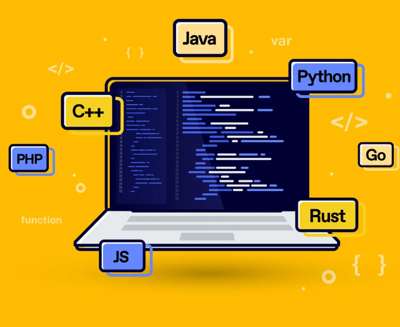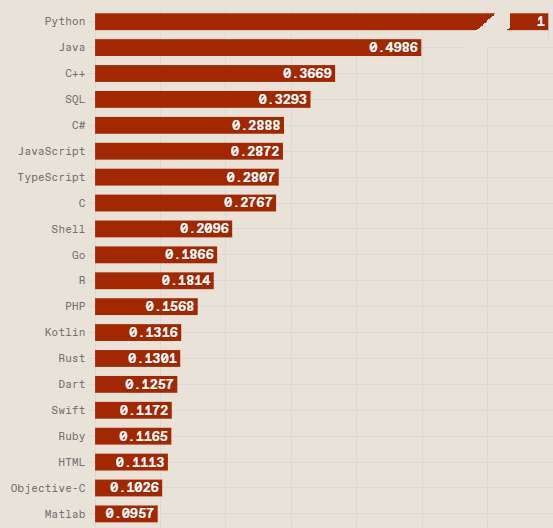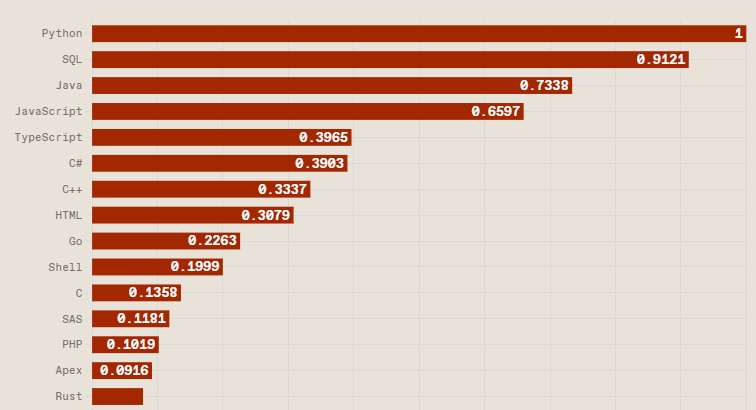| Python Supreme In Era Of AI |
| Written by Janet Swift | |||
| Wednesday, 24 September 2025 | |||
|
This finding comes from the latest IEEE Spectrum ranking of programming languages. But the rise of generative AI raises a lot of doubts for the future - including the need for a meaningful metric. This is the 12th year for IEEE Spectrum's annual Top Programming Languages exercise and Python has now come top in the Spectrum ranking in ten consecutive years. This year for the first time Python also comes first in the Jobs ranking displacing SQL, which had been top for four years in a row. This ranking exercise intended to estimate the relative popularity of different languages was devised in 2014 by IEEE Spectrum magazine in collaboration with Nick Diakopoulos, who at the time was a "data journalist" and is now is a professor in Communication Studies and Computer Science. Initially only 10 languages were included, although in the second year the number had risen to 48 languages. Looking back to the earliest rankings, four languages were clustered near the top. Java topped the index with 100 but C with 99.9 and C++ with 99.4. In 2016 C became the top language with Java at 98.1 and Python at 98.0. Python gained the top position in 2017 but C and Java were only a whisker behind - 99.7 and 99.5 respectively. Apart from the fact that the index is now normalised to 1, what is so very different in recent years is the distance between Python and the next highest language. For the Spectrum ranking in 2024 Python is 1 and Java is 0.4986, a distance of 0.5014, slightly lower than in 2024 when it was 0.5145. All the languages in the 2014/2015 Top Ten are in this year's Top Twenty - but Matlab, which was in #10 originally and is now in #20 now has an index of 0.0957 compared to 0.724 over a decade ago. This year 19 languages had a ranking over 0.1 in the Spectrum ranking compared to 15 last year. Over the course of the year JavaScript was the language that lost out most, going from #3 with 0.4451 to #6 with 0.2872. The Trending section follows the pattern of Python being well ahead of every other language with Java in second place with 0.6777 and C++ in third with 0.4458 after another substantial gap. For this ranking 23 languages were over the 0.1 threshold whereas turning to Jobs there were only 13. The important difference this year is that Python tops the list and the is a distance of 0.0879 between it and SQL which has dominated in this respect. As explained in previous years, the ranking combines metrics from multiple sources, including Google, GitHub, the IEEE Xplore Digital and IEEE Career Builder and uses different weighting for its different sections with the Jobs section of the index being the most straightforward to understand. Report on the 2025 results Stephen Cass notes on the impact of AI chatbots on Stack Overflow, another important source for the metric, revealing that the number of questions posted per week on Stack Exchange in 2025 was just 22 percent of what it was in 2024. Cass comments: With less signal in publicly available metrics, it becomes harder to track popularity across a broad range of languages. This existential problem for our rankings can be tackled by searching for new metrics, or trying to survey programmers—in all their variety—directly. Cass continues: However, an even more fundamental problem is looming in the wings. Whether it’s a seasoned coder using an AI to handle the grunt work, or a neophyte vibe coding a complete web app, AI assistance means that programmers can concern themselves less and less with the particulars of any language. First details of syntax, then flow control and functions, and so on up the levels of how a program is put together—more and more is being left to the AI. Discussing the ramifications of the rise of code-writing LLMs, Cass points out three things:
Cass concludes with: It’s likely that using LLMs to write and assist with code is something that’s going to stick. So we’re going to be spending the next 12 months figuring out what popularity means in this new age, and what metrics might be useful to measure. More InformationThe Top Programming Languages 2025 Related ArticlesPython Extends Its Lead In IEEE Spectrum Rankings (2023) IEEE Spectrum Ranks Languages (2022) Python Tops Language Rankings - Again (2021) Python Tops IEEE Spectrum's Rankings For Fourth Time (2020) Python Tops Language Ranking Again (IEEE 2018) Python Heads IEEE Spectrum Language Ranking (2017) Why Is C Top Language In IEEE Rankings? (2016) IEEE Custom Ranks Programming Languages (2015) To be informed about new articles on I Programmer, sign up for our weekly newsletter, subscribe to the RSS feed and follow us on Twitter, Facebook or Linkedin.
Comments
or email your comment to: comments@i-programmer.info
|
|||
| Last Updated ( Wednesday, 24 September 2025 ) |






